Hyperrhiz 13
Introduction
David M. Rieder
North Carolina State University
Citation: Rieder, David M.. “Introduction.” Hyperrhiz: New Media Cultures, no. 13, 2015. doi:10.20415/hyp/013.i01
Abstract: Issue 13 of Hyperrhiz, titled "Kits, Plans, and Schematics," celebrates recent work by academics and artists working at the intersection of today's maker culture and the digital humanities. The nine original works in this issue demonstrate some of the ways in which modern, Do-It-Yourself (DIY) practices of counter-cultural production combine with new, experimental forms of humanities scholarship.
For decades, maker culture has been a set of countervalent practices that define themselves in contrast to modern scientific methods that marginalize the amateur inventor, as well as against an ethos of complacency promoted by brought-to-you-by consumerism.
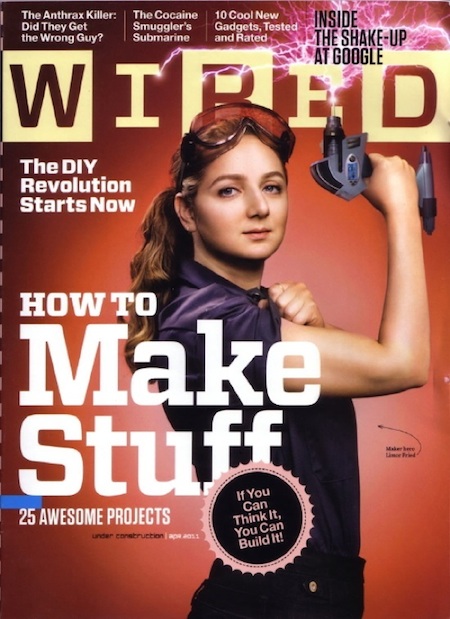
Makers like Limor Fried of Adafruit Industries, aka Lady Ada, epitomize an approach to making that celebrates creativity and experimentation in all kinds of materials — from sewing to soldering. Makers are expressive of an eclectic approach to cultural production. They are amateur experts contributing to a new wave of open 'wares of all kinds. They are hackers, tinkerers, bricoleurs.
Coalescing with the counter-tradition of maker culture is another form of eclecticism — a new approach to scholarship-as-making associated with the digital humanities (DH) that is not as well known. Compared to print- or text-centric approaches to DH, developed oftentimes in partnership with university libraries, this alternative approach to DH constitutes itself from a wide range of media and materials and is born oftentimes out of partnerships with digital media arts and theory. In addition, due in part to the lower levels of funding available, this counter-approach to DH shares with maker culture a kind of DIY attitude — an attitude made apparent in this issue of Hyperrhiz. The nine projects in this issue can be valued as an under-represented approach to maker culture associated with DH. If the tendency in DH is toward "big data," these projects are a contribution to a wave of works that exploit in novel forms of "small data."
Missives of love
The first section of the issue comprises three works that explore new ways of communicating feelings of love, hope, and appreciation in experimental media and materials.
David M. Rieder's "Dear Accelerometer" mashes together quotes from the interactive fiction story, "Dear Esther," with sounds and words associated with the migrant/refugee crisis in the Mediterranean Sea. Toward the end of "Dear Esther," a poignant scene of love and loss is represented by an "armada" of paper origami boats that the protagonist has made from letters he's written to his wife. Inspired by the scene, Rieder has prototyped the first of several origami boats that will wirelessly transmit accelerometer data to a Processing sketch. When one of his paper boats is picked up and moved around, a sample of voices, ambient sounds, and text-based missives associated with the crisis in the Mediterranean are mixed in novel combinations.
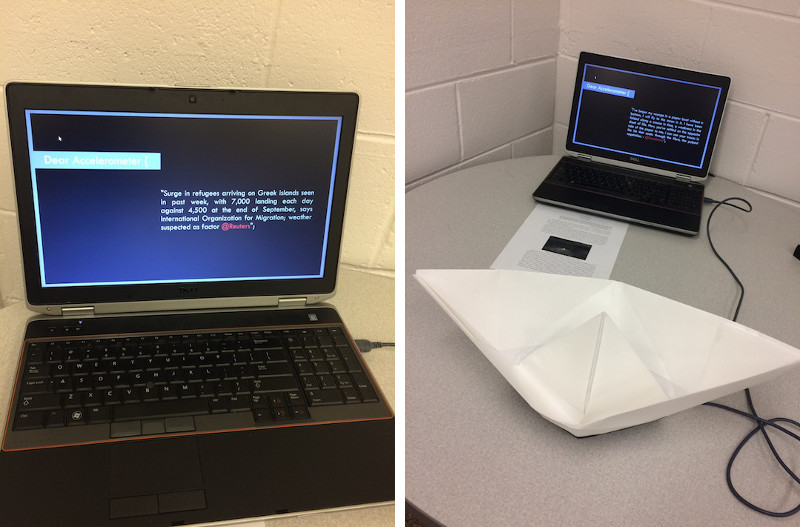
Next, Helen J. Burgess' "Love Notes and Intimate Circuits" is a provocative example of what Craig Saper might call an "intimate bureaucracy," which is a public communication network that has been exploited and folded back on itself to support "intimate" or personal forms of creativity. Poetic tweets from a cloud-based software program are sent to a small printer in an office or gallery space. The tweets communicate both the non-personal, bureaucratic aspects of global communication media and their potential for highly personal connections among readers. Burgess' work is a compelling example of the ways in which networked communication can be folded back toward a paradoxical kind of "extimacy," i.e., an intimacy of creative expression born of the seemingly impersonal character of abstract data.
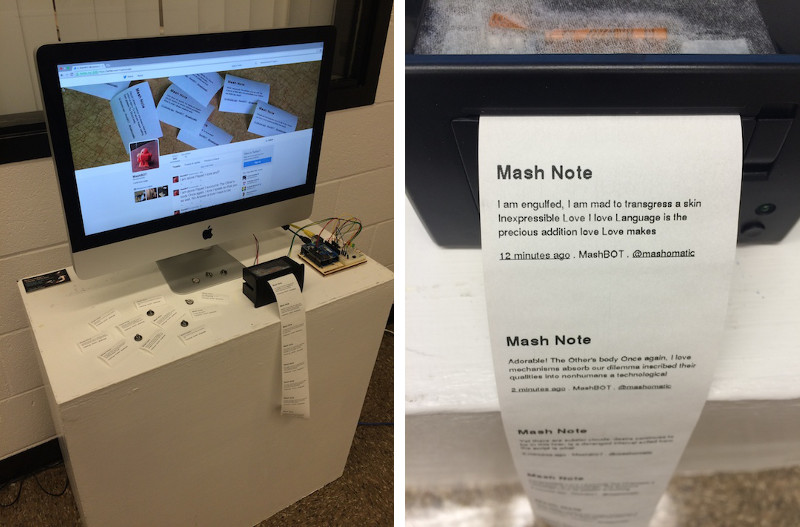
Finally, Melissa Rogers' "Making Queer Love: A Kit of Odds and Ends," celebrates the work of queer feminist crafters and artists by providing a set of materials and methods for writing letters of love to the heroines of the movement. The kit includes found materials associated with embroidery and cross-stitch, design patterns, and a love letter. The recipients of the kits are invited to engage in an extended network of solidarity, friendship, and affection with other makers and artists by stitching together the materials and words found in the mailing. Reminiscent of Hakim Bey's arguments against our increasingly mediated lives, Rogers' kit is a way of practicing immediatism. As we stitch together the materials in the kit, we engage directly in a queered network that veers away from mainstream practices of alienation. Crafting is lovemaking — a creative praxis that stitches together the disparate ends of the movement.
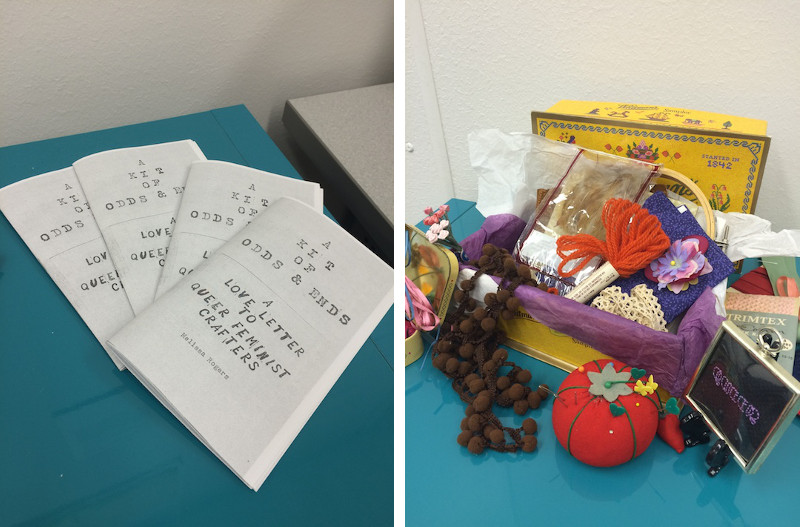
Sensors and databodies
In the next section are three projects that demonstrate some of the ways in which sensory or networked data can be used to "evert" some of our conventional expectations about space, sound, and some of our online wanderings.
In Jessica Handloff, Geoffrey Luurs, and Sarah Beth Evans' "Ambient Sole: A Digital Engagement Project," pedestrian movement is transformed into an interactive experience. Strips of conductive copper tape are placed across a matt on the floor. As participants walk across the matt, they complete one or more circuits, triggering one or more MP3 sound files. As the sound files play, participants become aware of their steps. The easily forgotten activity of walking is everted into a hybrid experience. For Handloff et al, the eversion of walking is a disruption that reveals some of the agency imbued with pedestrian spaces and the activity of walking. Reminiscent of Michel de Certeau's argument about the hidden power of walking to define a city's meaningfulness, "Ambient Sole" argues implicitly for the power of space-in-movement.

Next, Jay Kirby and Eddie Lohmeyer's project titled "The Body-Sonic" does something similar to Handloff et al's project: it uses sensory data to disrupt and foreground an easily-forgotten activity or movement; moreover, it, too, uses sound as a basis for the disruption. In simple terms, "The Body Sonic" is a muscle-sensing machine that makes music. As a user flexes her arm muscles, the muscular contractions and releases are transmitted to a Processing sketch that changes the way in which musical tracks are played. Their project collapses the boundary between listener and composer, as they become collaborators. Another all-too-easily forgotten aspect of embodiment is foregrounded, and its sensible energy translated into a novel, sonic engagement.
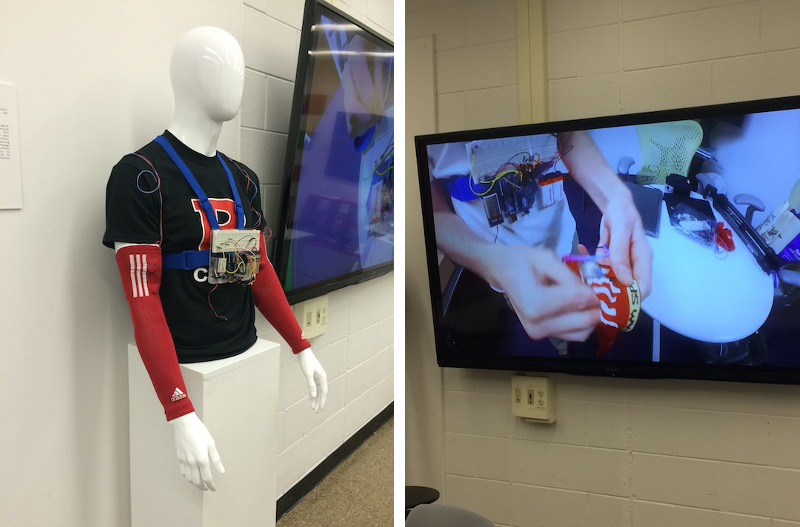
The last project in this section, "Manifest Data," is by Amanda Starling Gould, Luke Caldwell, Karin Denson, Shane Denson, and David Rambo from Duke University's Speculative Sensation (S-1) Lab. Like the other two projects, this one too disrupts our conventional relationship with embodied movement, but it does so at a different level of engagement. "Manifest Data" begins by recording and processing the data associated with a user's online activities. It recreates the disembodied, abstract data points associated with those activities into a sculpture that can be outputted in two different ways: as an AR (augmented reality) virtual data object, and as a hand-sculpted garden gnome enmeshed with the 3-D printed data object. The resulting "data gnomes" are an unique embodiment of a user's online movements.
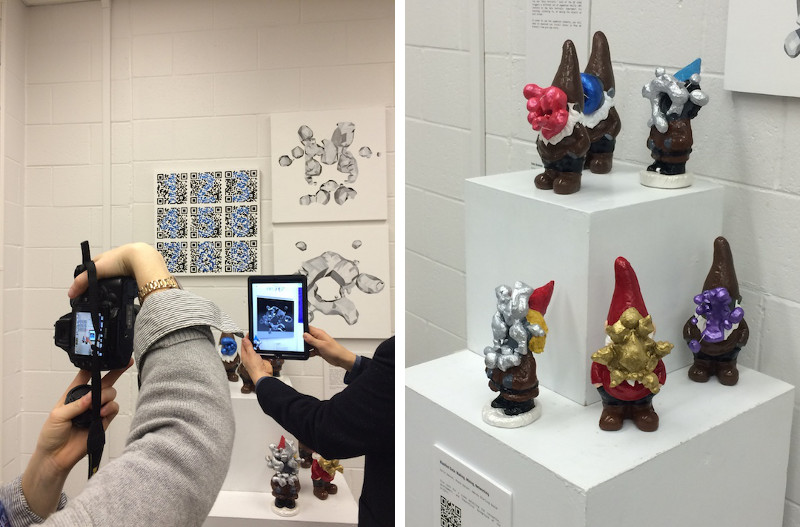
Workshops and kits for culture
The last group or projects foreground explicitly some of the ways in which the above-described maker culture and DH coalesce.
Ellen Foster's project titled "Critical Workshopping: The Contact Microphone," is a compelling example of the ways a hands-on, DIY-style project can be the basis for issues of empowerment and power-knowledge in techno-cultures. Foster explains that the practice of soldering is at the heart of her workshop because it is a fundamental skill within maker cultures. Learning how to solder together the parts required to make a contact microphone elicits a range of responses from participants that are indicative of their changing relations to the politics that undergird the technical.
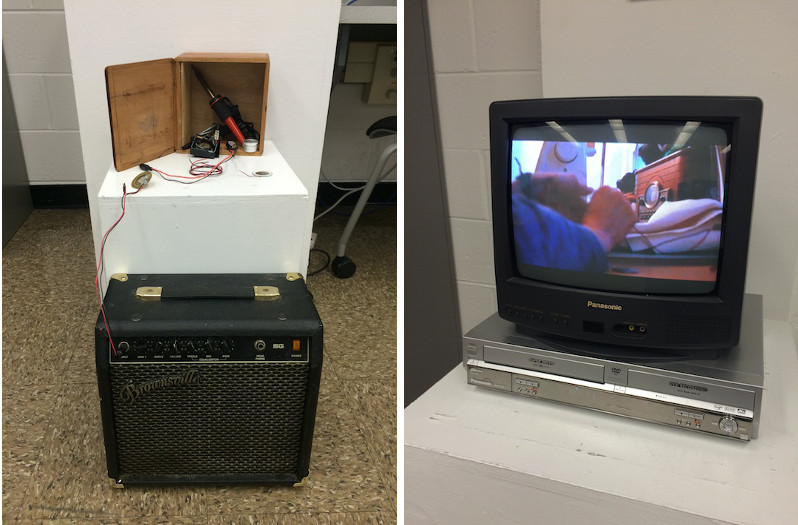
The second project is a kit by Jentery Sayers and members of the Maker Lab in the Humanities (MLab) at the University of Victoria, British Columbia, CA. Inspired in part by the kits designed by the Fluxus art group, the "Kits for Cultural History" project is a novel contribution to both DH research and the ways in which maker culture can influence DH methodologies. The kit presented in this issue demonstrates how historical objects can be recreated as part of a critical hermeneutics of learning and examination. Related to this demonstration is the shift away from exclusively textual or screenic forms of curation. Sayers and his team's kit, which was on hand at the Rutgers University-Camden Digital Studies Center, comprises several small drawers, hand-made objects, diagrams, and an accompanying booklet. Scholarly communication is radically remade.
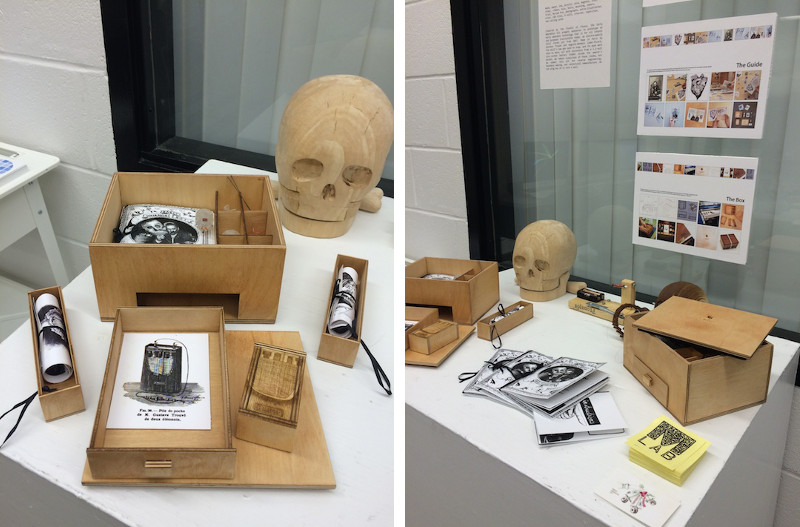
The last project in the issue is a collaboration between Lynn Tomlinson and Diane Kuthy. Their project, "Animating Imaginary Worlds: A Digital-Meets-Handmade Animation Workshop Kit," offers would-be animators a set of technologies, materials, and methods for developing original stories within a DIY, multimodal context. The workshop that Tomlinson and Kuthy have put together offers students at all levels of learning a hands-on approach to thinking about constructing stories in digital media. Their installation in the Rutgers University-Camden exhibit demonstrated some of what has made the maker movement a success. Participants were able to animate a story with cut-out imagery and gain a general understanding of animation principles outlined in the project's instructions.
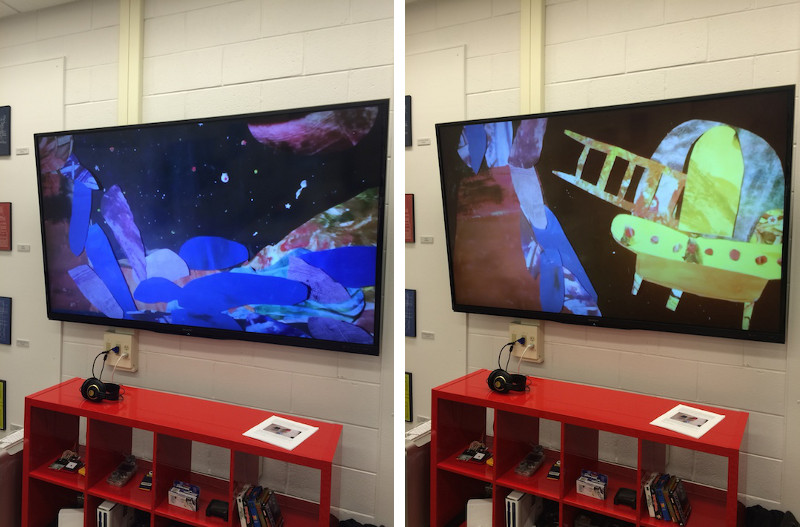
Concluding Statement: Executing Culture
The original call for papers for this issue asked for kits as examples of "executable culture": cultural objects that can be shared widely and downloaded for execution (building/rebuilding) as physical objects at the other end of the network. We were thus particularly pleased to be able to offer an "executed" version of the nine projects in an exhibit hosted by James J. Brown, Jr. and Robert A. Emmons, Jr., at the Rutgers University-Camden Digital Studies Center. We wish to thank Jim and Robert, along with all the authors in this issue, for their fine contributions to the DIY movement in humanities scholarship.